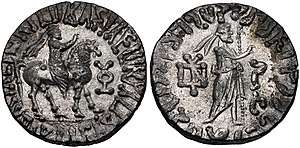Abdagases I
Abdagases I was an Indo-Parthian king, who ruled Gandhara and possibly roughly over the Indus region from c. 46 to 60. He was a nephew and successor of Gondophares, who had laid foundations to the Indo-Parthians after revolting against his Arsacid overlords in c. 19.[1] Abdagases was succeeded by Ortaghnes or Pacores.[2]
| Abdagases I | |
|---|---|
 | |
| Indo-Parthian king | |
| Reign | c. 46 – c. 60 |
| Predecessor | Gondophares |
| Successor | Ortaghnes or Pacores |
| Died | 60 |
| House | House of Suren |
| Religion | Mithraism (?)[a] |
Life
Abdagases belonged to the House of Suren, a prominent and influential family within the Arsacid Empire; he was succeeded by his uncle Gondophares as the ruler of Gandhara in c. 46, whilst Ortaghnes succeeded him at Drangiana and Arachosia.[3] The figure of Abdagases is obsecure; according to Gazerani, it is likely that Abdagases may have been the same person as another Abdagases,[4] an influential and powerful Suren noble in the Arsacid Empire, who belonged to a faction of Parthian magnates that were dissatisfied with the Parthian king Artabanus II. The Parthian magnates had at first favored a grandson of Phraates IV, also named Phraates as a more optimal king, who, however, met an abrupt death in Syria.[1] The Parthian magnates then turned to another prince, Tiridates III, who was crowned by Abdagases.[5]
Some of the Parthian magnates, however, went to the side of Artabanus II, due to their concern of Abdagases becoming the de facto ruler of the Arsacid Empire, with Tiridates as a figurehead.[5] As a result, Abdagases and his son Sinnacus withdrew their support from Tiridates as well.[5] This event seems to have coincided with the declarance of independence in Sakastan by the Suren family under Gondophares.[5] The identification of the two Abdagases figures, although supported by some scholars, nevertheless still remains indecisive, due to the lack of numismatic evidence.[5] Abdagases ruled as king till c. 60, and was succeeded by Ortaghnes or Pacores.[2]
Notes
^ a: The faith of the House of Suren remains uninvestigated in current scholarship. Pourshariati has suggested a faith based on the worship of Mithra being practiced by some of the Parthian families.[6]
References
- Gazerani 2015, pp. 24-25.
- Brunner 1982, p. 172.
- Rezakhani 2017, p. 37.
- Gazerani 2015, p. 24.
- Gazerani 2015, p. 25.
- Gazerani 2015, p. 111.
Sources
- Gazerani, Saghi (2015). The Sistani Cycle of Epics and Iran’s National History: On the Margins of Historiography. BRILL. pp. 1–250. ISBN 9789004282964.CS1 maint: ref=harv (link)
- Rezakhani, Khodadad (2017). ReOrienting the Sasanians: East Iran in Late Antiquity. Edinburgh University Press. pp. 1–256. ISBN 9781474400305.CS1 maint: ref=harv (link)
- Brunner, C. J. (1982). "Abdagases". Encyclopaedia Iranica, Vol. I, Fasc. 2. p. 172.CS1 maint: ref=harv (link)